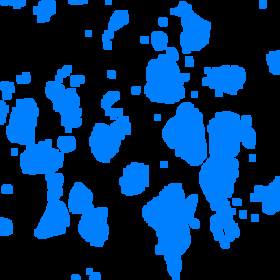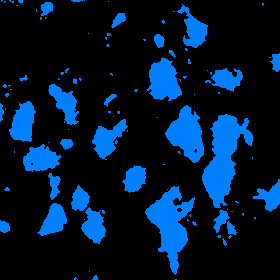SelectiveDilation2d
Dilates objects of a two-dimensional binary image conditionally to a local constraint.
Access to parameter description
For an introduction:
Using a threshold of 1 amounts to applying a standard morphological dilation.
This operator is smoother than a standard dilation, and softens the appearance of the structuring element in the filtered image.
Figure 1. Selective dilation effect: (a) The binary input image,
(b) standard dilation with 3 iterations, (c) selective dilation with 3 iterations, threshold = 5
See also
Access to parameter description
For an introduction:
- section Mathematical Morphology
- section Introduction To Dilation
Using a threshold of 1 amounts to applying a standard morphological dilation.
This operator is smoother than a standard dilation, and softens the appearance of the structuring element in the filtered image.
 (a) |
 (b) |
 (c) |
(b) standard dilation with 3 iterations, (c) selective dilation with 3 iterations, threshold = 5
See also
Function Syntax
This function returns outputBinaryImage.
// Function prototype
std::shared_ptr< iolink::ImageView > selectiveDilation2d( std::shared_ptr< iolink::ImageView > inputBinaryImage, uint32_t numberOfIterations, uint32_t threshold, std::shared_ptr< iolink::ImageView > outputBinaryImage = nullptr );
This function returns outputBinaryImage.
// Function prototype.
selective_dilation_2d(input_binary_image: idt.ImageType,
number_of_iterations: int = 3,
threshold: int = 5,
output_binary_image: idt.ImageType = None) -> idt.ImageType
This function returns outputBinaryImage.
// Function prototype.
public static IOLink.ImageView
SelectiveDilation2d( IOLink.ImageView inputBinaryImage,
UInt32 numberOfIterations = 3,
UInt32 threshold = 5,
IOLink.ImageView outputBinaryImage = null );
Class Syntax
Parameters
| Parameter Name | Description | Type | Supported Values | Default Value | |
|---|---|---|---|---|---|
 |
inputBinaryImage |
The binary input image. | Image | Binary | nullptr |
 |
numberOfIterations |
The number of iterations. | UInt32 | >=1 | 3 |
 |
threshold |
The minimum number of foreground neighbors that is required to transform a background pixel into a background one. | UInt32 | [1, 8] | 5 |
 |
outputBinaryImage |
The binary output image. Its size and type are forced to the same values as the input. | Image | nullptr | |
| Parameter Name | Description | Type | Supported Values | Default Value | |
|---|---|---|---|---|---|
 |
input_binary_image |
The binary input image. | image | Binary | None |
 |
number_of_iterations |
The number of iterations. | uint32 | >=1 | 3 |
 |
threshold |
The minimum number of foreground neighbors that is required to transform a background pixel into a background one. | uint32 | [1, 8] | 5 |
 |
output_binary_image |
The binary output image. Its size and type are forced to the same values as the input. | image | None | |
| Parameter Name | Description | Type | Supported Values | Default Value | |
|---|---|---|---|---|---|
 |
inputBinaryImage |
The binary input image. | Image | Binary | null |
 |
numberOfIterations |
The number of iterations. | UInt32 | >=1 | 3 |
 |
threshold |
The minimum number of foreground neighbors that is required to transform a background pixel into a background one. | UInt32 | [1, 8] | 5 |
 |
outputBinaryImage |
The binary output image. Its size and type are forced to the same values as the input. | Image | null | |
Object Examples
auto polystyrene_sep = readVipImage( std::string( IMAGEDEVDATA_IMAGES_FOLDER ) + "polystyrene_sep.vip" ); SelectiveDilation2d selectiveDilation2dAlgo; selectiveDilation2dAlgo.setInputBinaryImage( polystyrene_sep ); selectiveDilation2dAlgo.setNumberOfIterations( 3 ); selectiveDilation2dAlgo.setThreshold( 5 ); selectiveDilation2dAlgo.execute(); std::cout << "outputBinaryImage:" << selectiveDilation2dAlgo.outputBinaryImage()->toString();
polystyrene_sep = imagedev.read_vip_image(imagedev_data.get_image_path("polystyrene_sep.vip"))
selective_dilation_2d_algo = imagedev.SelectiveDilation2d()
selective_dilation_2d_algo.input_binary_image = polystyrene_sep
selective_dilation_2d_algo.number_of_iterations = 3
selective_dilation_2d_algo.threshold = 5
selective_dilation_2d_algo.execute()
print("output_binary_image:", str(selective_dilation_2d_algo.output_binary_image))
ImageView polystyrene_sep = Data.ReadVipImage( @"Data/images/polystyrene_sep.vip" );
SelectiveDilation2d selectiveDilation2dAlgo = new SelectiveDilation2d
{
inputBinaryImage = polystyrene_sep,
numberOfIterations = 3,
threshold = 5
};
selectiveDilation2dAlgo.Execute();
Console.WriteLine( "outputBinaryImage:" + selectiveDilation2dAlgo.outputBinaryImage.ToString() );
Function Examples
auto polystyrene_sep = readVipImage( std::string( IMAGEDEVDATA_IMAGES_FOLDER ) + "polystyrene_sep.vip" ); auto result = selectiveDilation2d( polystyrene_sep, 3, 5 ); std::cout << "outputBinaryImage:" << result->toString();
polystyrene_sep = imagedev.read_vip_image(imagedev_data.get_image_path("polystyrene_sep.vip"))
result = imagedev.selective_dilation_2d(polystyrene_sep, 3, 5)
print("output_binary_image:", str(result))
ImageView polystyrene_sep = Data.ReadVipImage( @"Data/images/polystyrene_sep.vip" ); IOLink.ImageView result = Processing.SelectiveDilation2d( polystyrene_sep, 3, 5 ); Console.WriteLine( "outputBinaryImage:" + result.ToString() );
© 2025 Thermo Fisher Scientific Inc. All rights reserved.